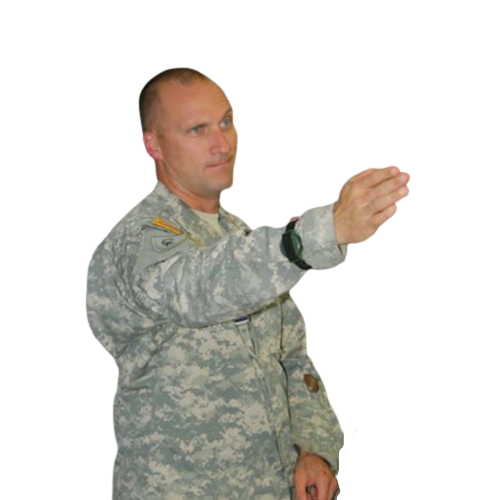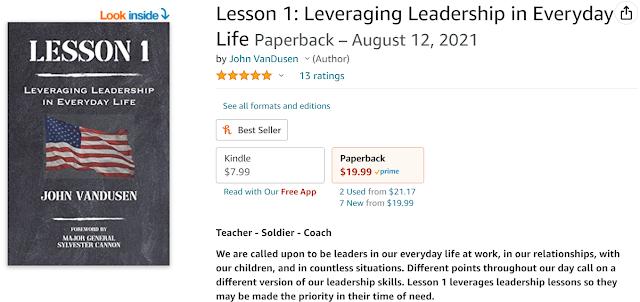Heck...growing up I didn't even like reading books! I was a big "BOOK IT!" person, but I only did that for the pizza.
My book "LESSON 1" was published on August 12, 2021. What an excellent experience!
Here's the story behind the story.Starting to Read: I would occasionally read a book in my adulthood. The first full book I remember reading was, "Rainbow Six" by Tom Clancy. I was in my 20s and had many more exciting things to do than read books. Even in college, I would do the absolute minimum amount of reading. I would lose focus, get to the bottom of a page, and have no idea what I had read.
I really started reading a lot when I was working full time for the Army in 2014-2016 because I found myself on an airplane every other week going to a conference, recon, or training event. I decided that because I spent so much seat time, I would become a reader.
I started with hard-copy books and found a few that I really enjoyed. Then I moved to digital books using my tablet and found it awesome that I could carry an infinite amount of books with me and read whatever I felt like. Sometimes I wanted to dig into the genius of Nick Saban or some other football coach while other times I just wanted a good Dan Brown story. I didn't read at home, only on the plane, so when I stopped flying all the time, I really stopped reading.
I go through phases of reading. For months at a time, I will read in the morning before I go to the gym. Then for months at a time, I won't.
Writing down angry notes: While at those conferences, recons, and training events, I found myself interacting with several different organizations, both military, and civilian. I found that many civilian organizations had much more efficient ways of doing things than we did in the Army. I would take those lessons back to my organization and implement what I could. I really enjoyed seeing how other organizations did the same things that we did. I enjoyed seeing how other organizations developed their task organizations, task management systems, and their ability to communicate laterally and vertically. Some of those things were able to fit into the Army, and others did not. Some of those things worked really well, and others made things worse.
I would take a few minutes after each trip to reflect on what went well and what I didn't like. I had a word document on my desktop and I would simply open it up, take a few minutes to type out some notes, then close it and wait until my next trip. There was no real format, organization, or thought behind my notes. Some of them were rants, and some of them looked like praise pieces.
Forgotten: In the fall of 2016, I transitioned from working full-time for the National Guard back into the classroom. I moved back to my hometown, was teaching a new subject, and my world was moving very fast! I had forgotten about my comments for months at a time. Once and a while I would be cleaning out my Google Drive and would say, "I remember this" and open up the document and reminisce about the great times I had in the Army. I would close it and move on to the next thing I had on my agenda, forgetting about my future book for another few months.
Kyle Anderson: I met Kyle during my first week of college and we became friends right away. He is still one of my very best friends over 20 years later. He published a book, "To The Edge: Successes & Failures Through Risk-Taking" on March 7, 2020.Kyle was the first person I had ever met that wrote a book. That was cool!
A week later our school shut down for the rest of the year due to the COVID-19 lockdowns. There I was, sitting in my upstairs bedroom, waiting for my students to log in to Google Classroom. It was a crazy time. I had a lot of time sitting. Waiting.
One morning I opened up that old document with my notes and started organizing it. I had 12 single-spaced pages of rants and rabble. I thought to myself, holy smokes...this could be a book! I started expanding on some of the topics, linking them to classroom and locker room issues and it started looking like a book. The title was a struggle- to learn more...buy the book.
Rejection: I talked with Kyle and he linked me up with his publisher. I sent my (VERY) rough draft to them and waited. They got back to me and said that due to the pandemic, they were understaffed and not taking on new authors, but encouraged me to try again.
Forgotten Part II: I had a fairly solid rough draft, but now it was summer and I was basically back to "normal" with my activities of fishing, four-wheeling, and preparing for my first year as a head coach for the freshman football team with all the intricacies of being a head coach combined with all of the external COVID-19 policies. School went back to in-person and combined with everything else, I was also prepping for hunting season.
In the fall of 2020, another book hit Amazon. "Daily STEM: How to Create a STEM Culture in Your Classrooms & Communities" by a friend of mine, Chris Woods. Chirs was the second person I had known to write a book. That was cool!
After football season, I talked with Chris and he linked me up with his publisher. They got back to me fairly quickly stating that they loved my book idea, but because they were in Canada, they felt it would be a better fit for a new publisher, "Road to Awesome."
BOOK: I had a conversation with Darrin M Peppard and he loved the idea of my book. Through several zoom calls, cover renditions, and grammatical editing, my book, "LESSON 1" was published and available on AMAZON on August 12, 2021. What an incredible experience!
Since then there have been some great conversations about my book and the leadership lessons contained within it. A huge thank you to Kyle and Chris for the motivation and to Darrin for taking a chance on me and my idea.






.png)



.png)